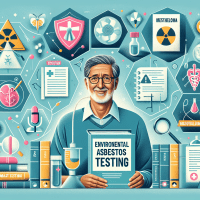Introduction: Our Shared Journey in Understanding Mesothelioma
Hello, my name is Sarah, and I have spent over 10 years as an oncology nurse, supporting patients and their families through the challenges of mesothelioma. I understand the weight of uncertainty that comes with a diagnosis and the stress of navigating environmental exposure risks. Today, I invite you to join me in this compassionate exploration of mesothelioma environmental exposure risks, a subject that affects not just our physical health, but our emotional well-being too.


Understanding Mesothelioma and Environmental Exposure Risks
Mesothelioma is a rare, aggressive cancer primarily caused by asbestos exposure. While industrial exposure remains a known risk factor, recent attention has focused on mesothelioma environmental exposure risks, where lingering asbestos particles in residential areas or surrounding the home can pose a threat. I have seen firsthand how fear and confusion can cloud one’s ability to understand these risks. My goal here is to provide clear insights on what environmental asbestos exposure means, its potential risks, and how to navigate these challenges with both factual clarity and empathetic support.
What is Environmental Asbestos Exposure?
Environmental asbestos exposure occurs when asbestos fibers are released into the air and enter homes, schools, or public areas. This may happen due to aging infrastructure, natural disturbances, or improper removal practices. The risk in such scenarios might not be as immediate as occupational exposure, but the cumulative effects over time can increase the chance of developing mesothelioma and other asbestos-related illnesses.
Recognizing the Risk Factors
It is important to realize that mesothelioma risk from environmental asbestos exposure may not have a rapid onset. It can take decades before symptoms appear. The insidious nature of this risk can make it even more challenging to address, and I encourage regular consultations with professionals if you suspect exposure in your environment.
Diagnosis, Staging, and What It Means for Your Treatment
After facing the emotional impact of a potential diagnosis, understanding the medical pathway is crucial. I recall many moments of uncertainty when I had to explain diagnostic tests and staging to worried families. Here is a brief overview:
Diagnostic Procedures and Biopsies
Common diagnostic methods include imaging tests such as CT scans and MRIs. When a suspicious mass is observed, minimally invasive biopsy procedures like thoracoscopy or thoracentesis are often used to obtain a sample.
The Mesothelioma Staging System
Staging determines the progression of mesothelioma:
| Stage | Description |
|---|---|
| Stage 1 | Localized cancer, often amenable to surgery. |
| Stage 2 | Cancer begins to spread but remains confined to one area. |
| Stage 3 | Cancer has spread to nearby tissues and lymph nodes. |
| Stage 4 | Advanced spread with significant systemic involvement. |
Understanding these stages helps tailor the treatment approach and provides a framework for the discussions you’ll have with your healthcare team. For further reading, check our internal articles on Mesothelioma Treatment Options and Mesothelioma Support Resources.
Treatment Options: A Comprehensive Look at Your Choices
When we talk about treatment, I speak from both professional experience and heartfelt compassion. I know that the word ‘treatment’ can sound daunting, but there are several avenues available:
Surgical Interventions and When They Apply
Surgery might be an option in the early stages (Stage 1 and sometimes Stage 2) to remove localized tumors. The goal is often to reduce the cancer burden and improve symptoms.
Chemotherapy and Radiation Therapies
For many patients, chemotherapy combined with radiation therapy is recommended to control or slow the progress of the disease. These treatments work by targeting rapidly dividing cells, though they can also affect healthy tissue. Adjustments and supportive care are essential in this phase.
Emerging and Targeted Therapies
In recent years, immunotherapy and targeted drug therapies have emerged as promising adjuncts to traditional treatments. These approaches aim to harness your body’s own defenses against cancer. I encourage you to discuss these options with a mesothelioma specialist who can tailor treatment to your unique situation.

Emotional Resilience and Coping Strategies
Dealing with mesothelioma is as much about maintaining emotional well-being as it is about medical care. Over the years, I have learned that emotional resilience is built through understanding, support, and self-compassion.
Managing Anxiety and Fear
It is natural to experience anxiety at every stage of your journey. Techniques such as mindfulness exercises, deep breathing, or even speaking with a trusted counselor can provide significant relief. I often remind myself and my patients that it’s okay to seek help when the emotional burden grows too heavy.
In my years of caring for mesothelioma patients, I’ve witnessed both the physical and emotional battles they face. One message that has always resonated with me is that every small step forward is a triumph. Your feelings are valid, and even in the darkest of times, there is hope and light to be found.
Care for Caregivers and Families
Remember that you are not alone. Support groups and counseling can be invaluable, and sometimes sharing experiences with others who understand can make all the difference. For more detailed support resources, please refer to trusted organizations such as the American Cancer Society and the Mesothelioma Applied Research Foundation.
Practical Steps for Navigating Your Path
Here are several actionable tips that have helped many individuals and families manage the challenges of mesothelioma:
- Consult Specialists: Ensure you meet with mesothelioma specialists who understand both the medical and environmental aspects of the disease.
- Ask Detailed Questions: When meeting your healthcare provider, consider asking about the type of asbestos exposure, diagnostic methods, treatment options, and potential side effects.
- Seek Emotional & Community Support: Join support groups, both online and in-person, to share experiences and gather insights from those on a similar journey.
- Regular Follow-Ups: Ensure consistent follow-up appointments. Mesothelioma is a dynamic condition, and regular monitoring is key.
It’s also important to recognize that while medical care is paramount, understanding the environmental factors that led to exposure empowers you to take preventive steps for yourself and your loved ones.
Every challenge you face is part of a larger story – one of resilience, courage, and community. Even in moments of uncertainty, I believe that sharing our stories and supporting one another can illuminate the path forward. I am here with you, every step of the way.
Looking Ahead: Next Steps & Additional Resources
As we conclude this discussion on mesothelioma environmental exposure risks, remember that your journey is deeply personal and unique. The insights shared here are based on my 10+ years caring for patients battling mesothelioma and come from a place of genuine empathy and commitment.
If you are searching for more information, I encourage you to further explore topics such as the latest in mesothelioma treatment research, caregiver support strategies, and legal resources that might be available if your exposure was linked to negligence. Transparency is key: our platform is supported by partnerships with reputable organizations, which allow us to offer this comprehensive information at no additional cost to you.
For additional clarity, consider using these steps as a checklist during your doctor appointments:
Questions to Ask Your Doctor
1. What specific tests are recommended for confirming mesothelioma?
Understanding the rationale behind tests such as CT scans or thoracoscopy can empower you to make informed decisions about your care.
2. How do my environmental exposure risks affect my treatment options?
Clarify the potential connections between past asbestos exposure and your current condition to better understand your treatment plan.
3. What support resources are available for both patients and caregivers?
Knowing where to turn during challenging moments can provide both practical help and emotional relief.
By asking these questions, you open the door to a more informed, compassionate discussion with your healthcare team.
Staying Informed
Keep in mind that the landscape of mesothelioma care is ever-evolving, with new research and treatment options emerging regularly. It is essential to continue seeking reliable information and connecting with healthcare professionals who understand your unique needs.
Throughout your journey, remember the power of community, compassion, and advocacy. Together, we can overcome obstacles and find pathways of hope, one step at a time.
Information on treatment guidelines is current as of May 2025. Always verify details with your healthcare provider and trusted institutions.
In Summary
Understanding mesothelioma environmental exposure risks is not just about grasping medical details—it’s about embracing hope, resilience, and the strength we discover in unity. I share this information with you as a fellow traveler who cares deeply about your wellbeing and future. Please continue to educate yourself, ask questions, and never shy away from seeking the support you deserve.
Thank you for allowing me to be part of your journey. You are valued, and your courage inspires me every day. Stay informed, stay supported, and most importantly, know that there is hope ahead.






